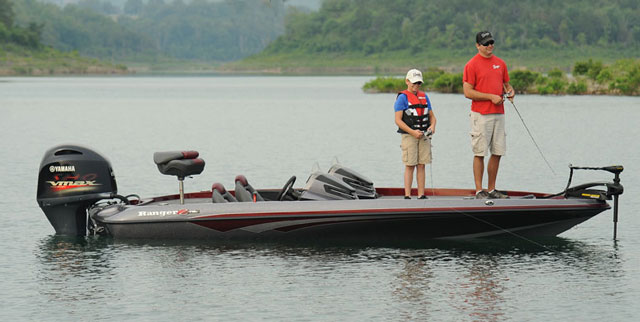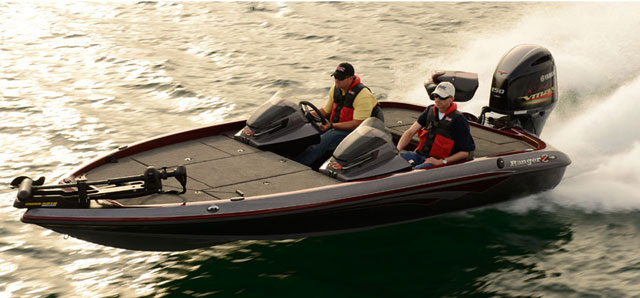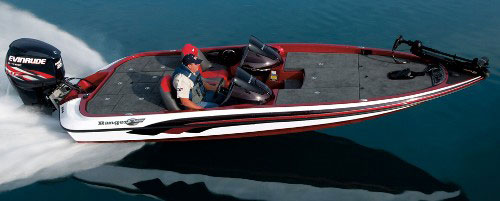Advertisement
Advertisement
Ranger Z118C: Bass Boat Pocket Rocket
The Ranger Z118 Comanche may be the smallest of the Z-series, but it still packs an explosive way to blast to the bass.
April 28, 2014
When we picked out 10 Top Bass Boats last year the Ranger Z-series accounted for two of our picks, and since that time this builder has expanded and improved its offerings—including a new lower-cost version of the smallest boat in this line, the Z118C.
We boaters usually think of smaller hulls as being less capable than their bigger brethren, but when it comes to the Z118C that’s simply not the case. Sure, there’s a bit less room. No, it can’t take as many horses on the transom. But all of the bass fishing advantages you expect out of a serious tournament fishing machine are present and accounted for.
The Z118C sticks with the Z-series basic platform: an aft casting deck, a small center cockpit with a pilot’s and co-pilot seat plus a small center seat that can be used when you have a third wheel onboard, and a spacious forward casting deck. Three can fish it, but two is the ideal crew. The foredeck houses a pair of eight-foot rodboxes, a tackle stowage center, a Minn Kota Maxxum 70 24-V electric trolling motor, a flat for a forward fishfinder, and a small drink cooler. The aft deck has bulk stowage compartments, and 23 gallons of livewell capacity. There are pedestal mounts for fishing seats or bike seats, and the helm feels more like that of a sports-car than a boat.
| Specifications | |
|---|---|
| Length | 18'8" |
| Beam | 7'10" |
| Draft | 1'3" |
| Deadrise | 16 degrees |
| Displacement | 1,550 lbs |
| Fuel capacity | 37 gal. |
So, what do you give up when compared to a full-size 21’ or 22’ bass boat—which might cost twice as much as this $40,000-ish (fully rigged and ready) 18-footer? Other than the obvious things (like elbow room, livewell and stowage capacity, and a bit of stability,) the main price you’ll pay comes in the form of performance. The max power on the Z118C is 150 horses, while a top-end, full-sized bass boat like the Z522 can take literally twice as much power. Depending on conditions, load, props, and other variables, that makes for a speed difference of about 20-mph; the Z118C tops out at just under 55 MPH, while its bigger brethren can hit speeds in the low 70’s. And “premium” 18-foot models, which can take another 50 horses or so, can be expected to run in the mid 60’s. Could these speed advantages make a difference in a big-money tournament? Maybe. But in reality, 50 MPH is plenty of speed, especially for those of us who spend the bulk of our time fishing on lakes and rivers where we have to dodge countless pontoon boats, PWCs, and bowriders, not to mention other anglers.

As long as top speed isn't your top priority - and for many of us it isn't - the Ranger Z118C will get the job done.
Handling, meanwhile, is much like that of the rest of the Z-series. The 118C Comanche is build on the same hull design, which incorporates a keel to enhance tracking and reduce lateral drift, a moderate 16 degrees of transom deadrise, and set-back transom. Construction also follows the Ranger norm, and includes highlights such as a molded foam-filled fiberglass stringer system, glass-filled strakes, and foam-filled cavities. The unique construction feature of note, however, is the use of pultruded parts in the transom, braces, and other critical areas of the boat. Pultrusion—the name comes by combining the words “pull” and “extrude”—is a process by which fiberglass is tensioned, rolled through a resin bath, and then pulled through a temperature-controlled die. The glass is resin-impregnated to the perfect level, excess gets squeezed away, and fibers are organized into specific shapes. The finished part is denser and stronger than normal fiberglass, which makes its use ideal in high-stress areas.
| Performance Data | |||
|---|---|---|---|
| Test conditions: calm seas, winds 0-5 knots, 2 POB | |||
| RPM | MPH | GPH | MPG |
| 1000 | 4.4 | 0.8 | 5.5 |
| 2000 | 7.3 | 2.4 | 3.0 |
| 3000 | 23.7 | 3.7 | 6.4 |
| 4000 | 35.5 | 7.2 | 4.9 |
| 5000 | 45.5 | 10.5 | 4.3 |
| 6000 | 54.9 | 15.8 | 3.5 |
| Power | Single Yamaha VF150LA, swinging a three-bladed stainless-steel 14.5" x 21" prop. Performance figures courtesy of Yamaha. | ||
There are a few other items that come standard on higher-end models but are cost-adding options in this case, which many serious bassers will consider must-haves. The Z118C doesn’t carry an onboard charger, doesn’t have a standard-issue fishfinder at the bow, and the standard Lowrance Mark 5X at the helm is pretty marginal by today’s standards; you’ll be a lot happier upgrading to something with a screen of at least seven inches. And as far as engine control goes, no self-respecting bass guy wants to use a standard throttle—upgrade to the Hot Foot pedal.
The bottom line? Bass boats can be expensive. Very expensive. Seeing Ranger roll out a new model that keeps price in check is a welcome development, to everyone—except for the bass.
See Ranger Z118C Comanche listings.
For more information, visit Ranger Boats.
Advertisement
Related Boats for Sale
See more boats like thisAdvertisement


















